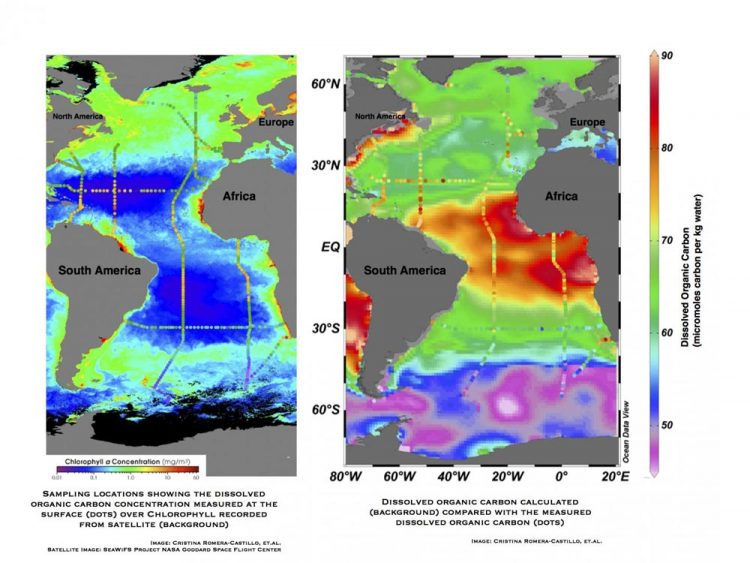UM researchers study vast carbon residue of ocean life

Left: Sampling locations showing the dissolved organic carbon concentration measured at the surface (dots) over Chlorophyll recorded from satellite (background) Right: Dissolved organic carbon calculated (background) compared with the measured dissolved organic carbon (dots) Image: Cristina Romera-Castillo, et.al. Satellite Image: SeaWiFS Project NASA Goddard Space Flight Center
The oceans hold a vast reservoir–700 billion tons–of carbon, dissolved in seawater as organic matter, often surviving for thousands of years after being produced by ocean life. Yet, little is known about how it is produced, or how it's being impacted by the many changes happening in the ocean.
Think of dissolved organic carbon, or DOC, in the ocean as tree leaves and other dead organic matter falling to the forest ground–a portion of this natural carbon sustains life while the remainder remains hidden in the soils, being sequestered for many years. As is true in the forests, this vital, residual carbon reservoir is necessary to sustain life in the ocean, and to sequester vast amounts of carbon in its great depths.
To better understand this important pool of ocean carbon, researchers at the University of Miami (UM) Rosenstiel School of Marine and Atmospheric Science used data collected over the past 15 years on several international scientific cruises to map the distribution of this material in the Atlantic Ocean. From the analysis, they found that this major basin contributes one third of the global ocean net production of dissolved organic carbon.
“Carbon is involved in all aspects of our life,” said Dennis Hansell, UM Rosenstiel School professor of ocean sciences and coauthor of the study. “We need to understand the carbon cycle on Earth especially as we add more from the burning of fossil fuels.”
Dissolved organic carbon is the primary food source at the base of the marine food chain. It is produced by phytoplankton during photosynthesis, and it is mostly consumed by microbial life. The remainder that is not consumed by microbes accumulates in the ocean.
The researchers discovered that the production of dissolved organic carbon at the ocean's surface could be accurately predicted by measuring the amount of nutrients arriving into the euphotic, or sunlit, zone. The nutrients arrive there mostly by winter mixing and upwelling, and in turn support the growth of ocean plant life. From the arrival of nutrients to the surface ocean, they estimated the resulting plant growth and the production of residue, the DOC, from that growth. From those estimates, they built a map of DOC at the surface of the entire Atlantic Ocean.
“In our work, we found that the production of dissolved organic carbon depends on the quantity of nutrients that reach the euphotic zone from deeper layers,” said Cristina Romera-Castillo, a former postdoctoral researcher at the UM Rosenstiel School and lead author of the study. “In future scenarios, how climate change will affect the nutrient arrival to the surface ocean will determine the inventory of dissolved organic carbon in the ocean.”
This inventory in turn affects the cycling of carbon on Earth, which has important roles in climate.
###
The paper, titled “New nutrients exert fundamental control on dissolved organic carbon accumulation in the surface Atlantic Ocean,” was published in the Proceedings of the National Academy of Sciences. The study's authors include: Cristina Romera-Castillo, who conducted the work while a postdoctoral researcher at the UM Rosenstiel School, UM Rosenstiel School Professor of Ocean Sciences Dennis Hansell, and Robert T. Letscher from the University of California Irvine.
The study was funded by grants from the National Science Foundation, Grant# OCE1436748 and the U.S. Department of Energy's Scientific Discovery through Advanced Computing program, Grant# DE-SC0012550
About the University of Miami's Rosenstiel School
The University of Miami is one of the largest private research institutions in the southeastern United States. The University's mission is to provide quality education, attract and retain outstanding students, support the faculty and their research, and build an endowment for University initiatives. Founded in the 1940's, the Rosenstiel School of Marine & Atmospheric Science has grown into one of the world's premier marine and atmospheric research institutions. Offering dynamic interdisciplinary academics, the Rosenstiel School is dedicated to helping communities to better understand the planet, participating in the establishment of environmental policies, and aiding in the improvement of society and quality of life. For more information, visit: http://www.
Media Contact
All latest news from the category: Earth Sciences
Earth Sciences (also referred to as Geosciences), which deals with basic issues surrounding our planet, plays a vital role in the area of energy and raw materials supply.
Earth Sciences comprises subjects such as geology, geography, geological informatics, paleontology, mineralogy, petrography, crystallography, geophysics, geodesy, glaciology, cartography, photogrammetry, meteorology and seismology, early-warning systems, earthquake research and polar research.
Newest articles

NASA: Mystery of life’s handedness deepens
The mystery of why life uses molecules with specific orientations has deepened with a NASA-funded discovery that RNA — a key molecule thought to have potentially held the instructions for…

What are the effects of historic lithium mining on water quality?
Study reveals low levels of common contaminants but high levels of other elements in waters associated with an abandoned lithium mine. Lithium ore and mining waste from a historic lithium…

Quantum-inspired design boosts efficiency of heat-to-electricity conversion
Rice engineers take unconventional route to improving thermophotovoltaic systems. Researchers at Rice University have found a new way to improve a key element of thermophotovoltaic (TPV) systems, which convert heat…



